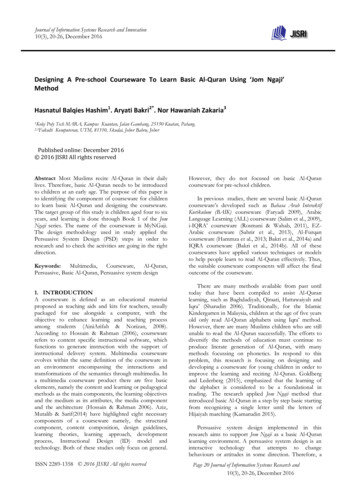
Transcription
Journal of Information Systems Research and Innovation10(3), 20-26, December 2016Designing A Pre-school Courseware To Learn Basic Al-Quran Using ‘Jom Ngaji’MethodHasnatul Balqies Hashim1. Aryati Bakri2*. Nor Hawaniah Zakaria31KolejPoly Tech MARA, Kampus Kuantan, Jalan Gambang, 25150 Kuatan, Pahang.Komputeran, UTM, 81310, Skudai, Johor Bahru, Johor2,3FakultiPublished online: December 2016 2016 JISRI All rights reservedAbstract Most Muslims recite Al-Quran in their dailylives. Therefore, basic Al-Quran needs to be introducedto children at an early age. The purpose of this paper isto identifying the component of courseware for childrento learn basic Al-Quran and designing the courseware.The target group of this study is children aged four to sixyears, and learning is done through Book 1 of the JomNgaji series. The name of the courseware is MyNGaji.The design methodology used in study applied thePersuasive System Design (PSD) steps in order toresearch and to check the activities are going in the rightdirection.Keywords:Multimedia, Courseware, Al-Quran,Persuasive, Basic Al-Quran, Persuasive system design1. INTRODUCTIONA courseware is defined as an educational materialproposed as teaching aids and kits for teachers, usuallypackaged for use alongside a computer, with theobjective to enhance learning and teaching processamong students (AiniArifah & Norizan, 2008).According to Hossain & Rahman (2006), coursewarerefers to content specific instructional software, whichfunctions to generate instruction with the support ofinstructional delivery system. Multimedia coursewareevolves within the same definition of the courseware inan environment encompassing the interactions andtransformations of the semantics through multimedia. Ina multimedia courseware product there are five basicelements, namely the content and learning or pedagogicalmethods as the main components, the learning objectivesand the medium as its attributes, the media componentand the architecture (Hossain & Rahman 2006). Aziz,Mutalib & Sarif(2014) have highlighted eight necessarycomponents of a courseware namely, the structuralcomponent, content composition, design guidelines,learning theories, learning approach, developmentprocess, Instructional Design (ID) model andtechnology. Both of these studies only focus on general.ISSN 2289-1358 2016 JISRI All rights reservedHowever, they do not focused on basic Al-Qurancourseware for pre-school children.In previous studies, there are several basic Al-Qurancourseware’s developed such as Bahasa Arab InteraktifKurikulum (BAIK) courseware (Faryadi 2009), ArabicLanguage Learning (ALL) courseware (Salim et al., 2009),i-IQRA’ courseware (Rosmani & Wahab, 2011), EZArabic courseware (Sahrir et al., 2013), Al-Furqancourseware (Hammza et al., 2013; Bakri et al., 2014a) andIQRA courseware (Bakri et al., 2014b). All of thesecoursewares have applied various techniques or modelsto help people learn to read Al-Quran effectively. Thus,the suitable courseware components will affect the finaloutcome of the courseware.There are many methods available from past untiltoday that have been compiled to assist Al-Quranlearning, such as Baghdadiyah, Qiraati, Hattawaiyah andIqra’ (Sharudin 2006). Traditionally, for the IslamicKindergarten in Malaysia, children at the age of five yearsold only read Al-Quran alphabets using Iqra’ method.However, there are many Muslims children who are stillunable to read the Al-Quran successfully. The efforts todiversify the methods of education must continue toproduce literate generation of Al-Quran, with manymethods focussing on phonetics. In respond to thisproblem, this research is focusing on designing anddeveloping a courseware for young children in order toimprove the learning and reciting Al-Quran. Goldbergand Lederberg (2015), emphasized that the learning ofthe alphabet is considered to be a foundational inreading. The research applied Jom Ngaji method thatintroduced basic Al-Quran in a step by step basic startingfrom recognizing a single letter until the letters ofHijaiyah marching (Kamarudin 2015).Persuasive system design implemented in thisresearch aims to support Jom Ngaji as a basic Al-Quranlearning environment. A persuasive system design is aninteractive technology that attempts to changebehaviours or attitudes in some direction. Therefore, aPage 20 Journal of Information Systems Research andInnovation10(3), 20-26, December 2016
Journal of Information Systems Research and Innovation10(3), 20-26, December 2016computer qualifies as a persuasive technology only whenthe individuals who make, disperse or embrace thetechnology do so with an aim to influence humanbehaviours and attitudes (Fogg 1998). Thus, this researchuses an interactive learning model using persuasivesystem design to support Jom Ngaji method as a device toinfluence children to learn Al-Quran characters and lastlythey can read and recite the Al-Quran successful. Thetarget audience for this project is children four to sixyears old, currently registered with a kindergarten at PulaiJaya, Johor.Flashcards is recognized as a tool to improvinglearning (Diouri, 2009). Recent studies on basic AlQuran coursewares including Al-Furqan courseware(Bakri, Zakaria, et al., 2014a) and IQRA courseware(Bakri et al., 2014b) have applied electronics flashcardcomponent to teach children effectively. Thus, in thisresearch, the use of electronics flashcard is embedded inthe courseware developed to help children to in the AlQuran learning. To the best of researcher knowledge,there are no studies that focus on coursewarecomponent with electronics flashcard using Jom Ngajimethod for children aged between four to six years old.2. DESIGN METHODOLOGYThe main objective of this paper was to design acourseware, the MyNGaji. The phases involved aredetermining the courseware components, and designingthe model phase.2.1 Courseware ComponentA comprehensive literature review was conducted tohelp determining the components for the courseware,Table 1.Table 1 : Related Learning CoursewareCoursewarei-IQRA’(Rosmani& Wahab,2011)MyFurqan(Bakri etal., 2014a)IQRA(Bakri etal., 2014b)V-Hajj(Yusoff etal., 2011)SmokerShooter(Ismail etal., 2012)PersuasiveMultimedia LearningTheoryFlashcardimplemented multimedia elements in their courseware,with the exception of smoker shooter courseware. Twocourseware have implemented learning theory and twocourseware have implemented flashcards. Thus, it isinferred that the persuasive principles is suitable to applyin learning courseware for children to persuade them tolearn basic Al-Quran effectively. Other than that,multimedia elements and learning theory are alsoimportant to motivate children to learning have somefun while. Flashcards is the most suitable for children tolearn quickly. But, all of these coursewares do notimplement the edugames application in their learningcourseware models. Hence, this study would be thesignificant interest as it includes edugames to enhancetheir learning process.The courseware components design as shown inFigure 1. The entire component will be integrated in theinitial courseware components to persuade youngchildren to learn basic Al-Quran successful.MultimediaElementsDualcodingTheory'Jom Ngaji 'CoursewareFlashcardsPersuasivePrinciplesFigure 1: Courseware componentsEach element of courseware components isexplained in detail as follows; All courseware’s, namely, i-IQRA’ courseware, AlFurqan courseware, IQRA courseware, V-Hajjcourseware and Smoker Shooter courseware haveimplemented persuasive principles in their learningcourseware. While, only four courseware hasISSN 2289-1358 2016 JISRI All rights reserved2.1.1 Persuasive PrinciplesFogg (2003b) has identified seven types of persuasiveprinciples. In MyNGaji courseware components for eflashcards, only four principles are adopted, includingreduction, tunneling, tailoring and suggestion. Table 2summarizes the persuasive principles used in thecourseware development for e-flashcards.The courseware features enable the persuasiveprinciples to be utilized in the courseware development.With the use of suitable principles, it is believed that withprolonged usage of courseware the behaviour of targetgroup can be achieved, as intended. The persuasiveprinciples used in the courseware development for eflashcards are reduction, tunneling, tailoring andsuggestion.Page 21 Journal of Information Systems Research andInnovation10(3), 20-26, December 2016
Journal of Information Systems Research and Innovation10(3), 20-26, December 2016Table 2: Persuasive principles used in coursewaredevelopment for flashcards (Adopted by Fogg throughsimplifyingandreducing complexbehaviourtosimple tasks.TunnelingGuideusersthroughapredeterminedstep by step ofactions or asedonindividual needs,interests,personality, usagecontext and so on.SuggestionIntervene or offersuggestions to theusers at the econtentareseparated into five modulesusing Jom Ngaji method whichare Kenal Huruf, Huruf Bersambung,Kenal Baris, 2 Harakat and MadAsli 2 Harakat. It is not mix upas it will confuse childrenconcentration. Each module islabelled clearly and not hiddenunder module.Each module of flashcards istimed less than 3 minutes forchildren learn in one time. Longtime stay on same flashcard willget them bored and lost theirfocus.For each video flashcard, userclicked on the video file and thevideo run until the end rseware sound quality issufficiently loud for normalhearing.Static images applied in thecourseware are easily distractedby other moving objects.Wording used should besufficiently clear to be seen tocapture children focus.Courseware offers suggestions tochoose the modules to learnweather Kenal Huruf, HurufBersambung, Kenal Baris, 2 Harakator Mad Asli 2 Harakat.Coursewareimplementsrepetition concept especially onmodule chosen to learn themodule over again.and animation. It makes the courseware more attractivefor children to learn. The elements are explained asfollows;(i)TextThe design should be easy to read and appropriate forchildren, with clear Al-Quran alphabet font size and styleto make the courseware more attractive to learn.(ii)AudioThe audio for this courseware should attached childrenvoices, especially for songs in Arabic alphabet. Text andgraphics are useless without sound. This would make thecourseware more interactive to learn.(iii)GraphicsThe design uses beautiful and cheerful wallpaper, suitableto attract children’s interest to learn basic Al-Quran usinge-flashcards.(iv)AnimationThe design of animation is useful in children educationarea. The animation can be much easier to understandrather than of video element. E-flashcards would applytext animation in its courseware development. Figure 2shows the implementation of multimedia elements inflashcards courseware. All the elements applied in thecourseware would hold the children’s attention to learnbasic Al-Quran.GraphicsAnimationText and audioFigure 2: Adopted multimedia elements in e-flashcardscourseware2.1.3 Dual-coding Theory2.1.2 Multimedia ElementsMultimedia elements are required to provide a goodpersuasive impact to the children. Multimedia is acombination of various media elements, such as text,audio, graphics, video and animation (AiniArifah &Norizan, 2008; Isa et al., 2010; Rosmani & Wahab, 2011;Yoag et al., 2012; Kamaruddin, 2015). This courseware isdeveloped based on integration of text, audio, graphicsISSN 2289-1358 2016 JISRI All rights reservedAccording to Paivio (2006), the dual-coding theory hastwo sets of codes, including visual codes and verbalcodes, sometimes referred to as symbolic codes, whichcan be represented by letters, numbers or words. Whenlearners are presented with both visual and verbal codeswhich are functionally independent, this has additionaleffects on their recall. Rieber (1994) reported that it iseasier to recall information from visual processing codesthan verbal codes because visual information is accessedusing synchronous processing, rather than sequentialPage 22 Journal of Information Systems Research andInnovation10(3), 20-26, December 2016
Journal of Information Systems Research and Innovation10(3), 20-26, December 2016processing. The multimedia instruction effectivenessincreases when verbal codes (such as letters, numbersand words) and visual codes (such as pictures) arepresented simultaneously as shown in Figure 3. In thefield of basic Al-Quran learning, the verbal and visual isvery important to children learning the language.redVisual codeblackwhiteVerbal codeFigure 3: Adopted dual-coding theory in flashcardscourseware2.1.4 E-FlashcardsIn MyNGaji courseware, the texts, pictures, animationsand sounds are applied on e-flashcard. The backgroundcolour of e-flashcard is white and half of the flashcard’ssize is filled with picture, basic Al-Quran letter andanimation. Figure 4 shows an example of e-flashcard thathas been implemented on MyNGaji courseware. Thecolours used in the e-flashcard are red, black, and whitebecause of their limited sense of prime colour(Muhamamad and Nawi 2011).There are many advantages of learning basic with eflashcards, some of which are as follows;i. Portable: The e-flashcards can be accessed anywherefrom any smart phones and computers.ii. Audio-based: The audio component of the cardshelps children to hear the correct nativepronunciation of the vocabulary or expression.iii. Visual: The e-flashcards with their visual content(text and images) accommodate children with a visuallearning style.iv. Interactive: Children can find the interactiveness ofthe tool extremely valuable.v. Flexible: Can be accessed online or offline and everychild has access to the same set of cards. They do notsuffer from being misplaced, getting torn or coffeestrained due to wear and tear like paper flashcards.vi. Friendly to
Flashcards is recognized as a tool to improving learning (Diouri, 2009). Recent studies on basic Al-Quran coursewares including Al-Furqan courseware (Bakri, Zakaria, et al., 2014a) and IQRA courseware (Bakri et al., 2014b) have applied electronics flashcard component to teach children effectively. Thus, in











